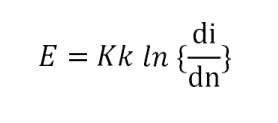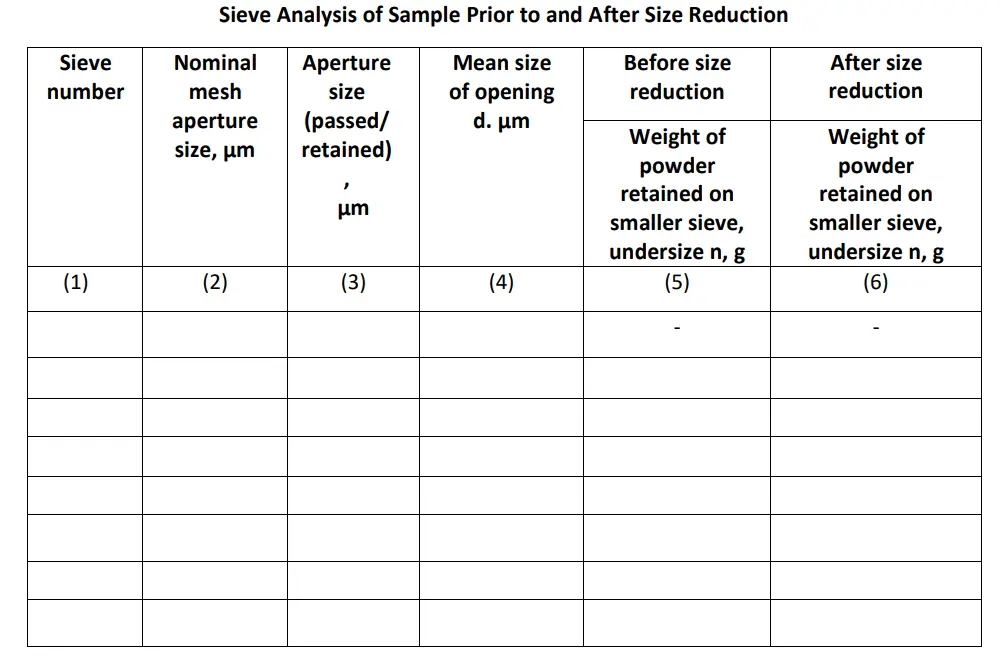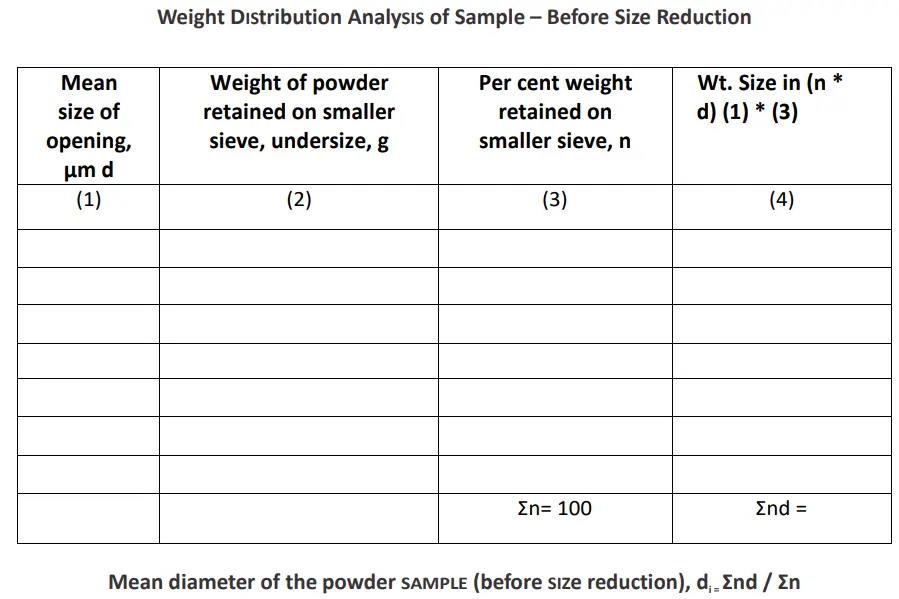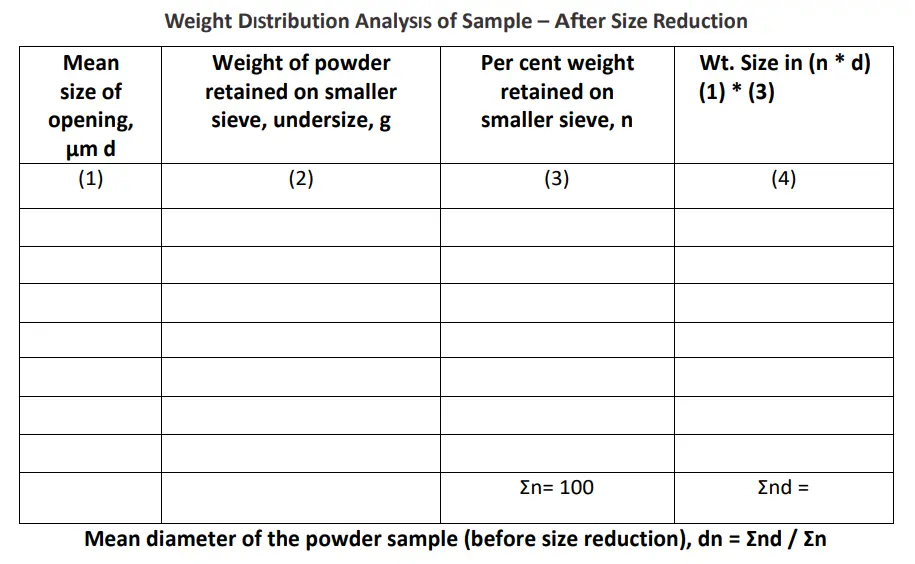Learn to verify the laws of size reduction using Ball mill and calculate Kick’s constant, Rittinger constant and Bond work index of ball mill.
To verify the laws of size reduction using Ball mill
To verify the laws of size reduction using a ball mill, you would typically perform an experiment to measure the particle size before and after milling, and then analyze the data to determine if it follows the expected laws.
The laws of size reduction, also known as the “kick’s laws,” are empirical relationships that describe the energy requirements for size reduction processes.
Aim
To verify the laws of size reduction using Ball mill and calculate Kick’s constant, Rittinger’s constant, and Bond’s work index of ball mill.
Requirements
- Powder sample
- Ball mill
- Gyratory Sieve shaker
- Sieve set
- Balance
- Energy Meter
What is Size Reduction?
Size reduction is the process of reducing the particle size of a substance to a finer and smaller piece to coarse particles or to powder. Size reduction process is also refer the comminution and grinding. When the particle size of solids is reduce by mechanical means it is known as milling.
Mechanism of Size Reduction:
- Cutting – Here the material is cut by means of a sharp blade or blades. Eg: Cutter mill
- Compression – In this method, the material is crush between the rollers by application of pressure. Eg: Roller mill
- Impact – Impact occurs when the material is more or less stationary and is hit by an object moving at high speed or when the moving particle strikes a stationary surface. In either case, the material shatters to smaller pieces.
Usually both will take place, since the substance is hit by a moving hammer and the particles formed are then thrown against the casing of the machine. Eg: Hammermill
- Impact & Attrition – In attrition, the material is subjected to pressure as in compression, along with impact. Ball mill
Principle To verify the laws of size reduction using Ball mill
A ball mill consisting of hallow cylinder mounted on a metallic frame such that it can be rotated along its longitudinal axis with balls of different diameter which occupy 30-50%of the volume and its size depends on the feed and mill size. The large balls tend to break down the coarse feed material and smaller balls tend to form fine product by reducing void spaces between the balls. Ball mills grind material by impact and attrition.
The degree of milling in a ball is influenced by:
- Residence time of the material in the mill chamber.
- The size, density and number of the balls.
- The nature of the balls (hardness of the grinding material)
- Feed rate and feed level in the vessel.
- Rotation speed of the cylinder.
Several types of ball mill exist. They differ to an extent in their operating principles. They also differ in their maximum capacity of the milling vessel, ranging from 0.010 liters for planetary ball mill, mixer mill or vibration ball mill to several 100 liters for horizontal rolling ball mills.
In multilayer filling mill by grinding media depending on the rotational speed, there is possible line of the
following modes the grinding media motion:
a) Cascade mode transport: Speed mode with a rolling of grinding balls, but without they flight.
b) Mixed mode motion: Speed mode with a portal rolling and a portal flight of grinding balls.
c) Waterfall mode motion: Speed mode with flying of grinding balls.
Objectives:
- Size reduction leads to increase surface area.
- Shows around five times better absorption.
- Size reduction produces particles in narrow size range. Mixing of powders with narrow size range is easier.
- Pharmaceutical capsule, insufficient (i.e., powder inhaled directly into lungs), Suppositories and ointments require particles size to be below 60 mm size.
Theories of milling
A number of theories have been proposed to establish a relationship between energy input and degree of size reduction produced. A general equation giving the power required for size reduction is

From this can be derived the following laws:
Kick’s law (Kick’s Theory):
It states that the energy required for the size reduction is proportional to the logarithmic of the ration between the initial and final size. It assumed that the energy required to reduce a material in size was directly proportional to the size reduction ratio dL/L. This leads to n= -1. Then,

Where,
- Kk =Kicks constant
- E = Amount of energy required to produce a change in unit mass (kW.h)
- d1= Initial particle size of sample (Before size reduction) (µm)
- dn= Final particle size of sample (µm). For crushing (Compression) of large particles, kick’s equation is more useful.
Rittinger’s law (Rittinger’s Theory)
It states that the energy consumed in the size reduction of solid is directly proportional the new surface created. It assumed that the energy required for size reduction is directly proportional, not to the change in length dimensions, but to the change in surface area. This leads to n -2 and K= K fc Then,

Where,
- E= Amount of energy required to produce a change in unit mass kW.h
- K = Rittinger’s constant, energy per unit area, KW.h/µm3
- It is mostly applicable to brittle materials undergoing fine milling. It ignores particle deformation before fracture.
Bond’s work index (Bond’s Theory)
It states that the energy used for deforming a set of particles of equivalent shape is proportional to the change in particle dimensions Means, energy used in crack proportional to the change length produced. According to bond’s theory, the equation is:

- E= Energy required for size reduction
- KB= Bond’s work index, energy per unit mass, kW.h.
- di= Initial diameter of particle
- dn= Final diameter of particles.
The bond’s useful work index is a useful way for comparing the efficiency of milling operation. This is useful for rough mill size.
Procedure to verify the laws of size reduction using Ball mill
- Note the initial dial reading of energy meter as N1.
- Take the clean metal chamber (of ball mill) with sufficient number of balls.
- Operate the ball mill without load for 30min.
- Note the reading (revolutions) in energy meter is as, N2. (The difference, i.e., N3=N2 –N1 gives the energy required for running the ball mill without feed).
- Weigh Hundred grams of sample and subjected to sieve analysis. Calculate the average particle size of the sample.
- Transfer the Hundred grams of feed into the ball mill.
- Operate the ball mill for 30minutes.
- Note down the reading (revolutions) as N4. (The difference, i.e., N5 =N4–N2 gives the energy required for running the ball mill and size reduction of material).
- The difference, i.e., N6 =N5 –N3, gives the energy actually consumed for the size reduction material.
- Now unload the product onto a tray and subjected for sieve analysis.
- Determine the average particle size of the product reduction.
- Substitute the data in respective equation for obtaining Kick’s constant, Rittinger’s constant and Bond’s work index respectively.



Observation and Calculations
- Initial reading of energy meter, N1 =
- Energy meter reading by the use of ball mill without feed, N2 =
- Energy consumed by the ball mill, N3 = (N2-N1) =
- Energy meter reading after the use of ball mill with feed, N4 =
- Energy consumed for size reduction plus the ball mill, N5 = N4=
- Energy consumed for size reduction, N6 = (N5-N3) =
Weight of the sample taken, W= (100gm) 0.1kg
Calculation of energy meter constant E (on the energy meter, the relationship between the revolutions and energy given. Use that relationship for calculations):
750 units reading (revolutions) the energy = 3600 kW.s (1 kW.h)
1 unit reading =?
1 unit = 3600 / 750 = 4.8 kJ (E)
Energy on no load, E1=N3 * E = ………kJ
Energy on load, E2 = N5 * E = …………kJ
Net Energy required per unit mass = {(E2 – E1)/w} =. ……. kJ
Average particle diameter of feed, di = ………. µm
Average particle diameter of product, dn = µm
The energy required to reduce the size of particles can be calculated by Rittinger’s equation and Bond’s equation. The principle involved is the determination of mean particle size of material before and after size reduction. These changes are related to the energy consumed for size reduction.
Result
- Rittinger’s Constant=
- Kick’s Constant=
- Bonds Work Index=
